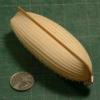-
Posts
13,051 -
Joined
-
Last visited
Content Type
Profiles
Forums
Gallery
Events
Posts posted by druxey
-
-
-
-
The usual way to use rubber cement is to coat both surfaces to be glued, allow the solvent to dry, then press the parts together like contact cement. Until you press firmly, there is wiggle room to adjust. A piece of crepe rubber works just as well as your finger!
A word of caution: after some years the rubber deteriorates and turns the card brown as well as loses adhesiveness.
- BETAQDAVE and thibaultron
-
 2
2
-
Very impressive. Would dampening the houtbord help prevent it splitting while shaping it?
- thibaultron and mtaylor
-
 2
2
-
-
Nice internal strops, Michael!
- cog, mtaylor and popeye the sailor
-
 3
3
-
Mark: a small point about the knuckle moulding (between lower and upper counters): the lower edge of this moulding sits about an inch below the lower counter plank surface to form a drip edge. I discovered this from examining contemporary museum models. In the last photo it looks to sit about an inch above the planking.
- Hubac's Historian, mtaylor, daHeld73 and 1 other
-
 4
4
-
-
-
-
Looks terrific, Michael. Take care when working aloft!
-
The lower photo (repeated) looks about right. I believe that it was Longridge who stated that this troublesome piece was shaped from solid rather than steam bent. I found that I had to slide that triangular piece in from above (if the hull is right side up!) and aft, down and forward, for a nice fit.
-
-
The kit is just trying to give the impression that Allan's posting shows. The 'netting' in the photo is not it!
- mtaylor, thibaultron and marktiedens
-
 3
3
-
Impressive, Dan! Well done. Aren't you going to build the rest of the Yamaha models as well?

- popeye the sailor and Canute
-
 2
2
-
-
-
If you are using nothing but straight, parallel strips, you will probably not only have difficulties but will be unhappy with the results. The only surface you can satisfactorily plank with straight strips is the side of a house. Boats aren't that shape, unfortunately. However, it's your model and your decision!
-
-
-
I agree that, with a cast gun, boring the barrel accurately is tricky. I made a molded fixture to hold the guns consistently vertical and centered in a machine vice so that the drill entered concentric to each gun.
- daHeld73, paulsutcliffe and mtaylor
-
 3
3
-
Good question, Dirk. The English also made repairs and replacements easier by through-bolts that were forelocked. How early this practice began, I'm not sure.
-
I use the MicroMark lead-free pewter. As for all casting metals, you ned to skim off the dross before pouring. I can see that the urn-shaped opening might create a bottleneck/backup, allowing cooling to occur before complete filling of your mold.
If low melting point is an issue, there is always Wood's Metal - it flows at below the boiling point of water! I've no idea what blackening agent might work on it, though. Cerrosafe is a non-toxic alternative.
-
Congratulations on a fine result, Thunder. I remember seeing advertisements in Model Shipwright back in the '80s and wondered if the kit was as good as the photo in their ad. It is.



Difference between a deadeye and a clump block
in Masting, rigging and sails
Posted
From the description, a clump block is what was earlier termed a 'thick' block. There were regularly proportioned blocks, as well as 'thin' blocks. The latter were, as implied, thinner for their length and were reeved with a lighter line than the regular version. Presumably 'thick' or 'clump' blocks carried lines of larger size than their 'normal' counterparts.